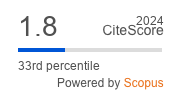Comparative Evaluation of IndoBERT, IndoBERTweet, and mBERT for Multilabel Student Feedback Classification
Abstract
Student feedback plays a crucial role in enhancing the quality of educational programs, yet analyzing this feedback, especially in informal contexts, remains challenging. In Indonesia, where student comments often include colloquial language and vary widely in content, effective multilabel classification is essential to accurately identify the aspects of courses being critiqued. Despite the development of several BERT-based models, the effectiveness of these models for classifying informal Indonesian text remains underexplored. Here we evaluate the performance of three BERT variants—IndoBERT, IndoBERTweet, and mBERT—on the task of multilabel classification of student feedback. Our experiments investigate the impact of different sequence lengths and truncation strategies on model performance. We find that IndoBERTweet, with a macro F1-score of 0.8462, outperforms IndoBERT (0.8243) and mBERT (0.8230) when using a sequence length of 64 tokens and truncation at the end. These findings suggest that IndoBERTweet is well-suited for handling the informal, abbreviated text common in Indonesian student feedback, providing a robust tool for educational institutions aiming for actionable insights from student comments.
Downloads
References
Copyright (c) 2024 Jurnal RESTI (Rekayasa Sistem dan Teknologi Informasi)

This work is licensed under a Creative Commons Attribution 4.0 International License.
Copyright in each article belongs to the author
- The author acknowledges that the RESTI Journal (System Engineering and Information Technology) is the first publisher to publish with a license Creative Commons Attribution 4.0 International License.
- Authors can enter writing separately, arrange the non-exclusive distribution of manuscripts that have been published in this journal into other versions (eg sent to the author's institutional repository, publication in a book, etc.), by acknowledging that the manuscript has been published for the first time in the RESTI (Rekayasa Sistem dan Teknologi Informasi) journal ;








